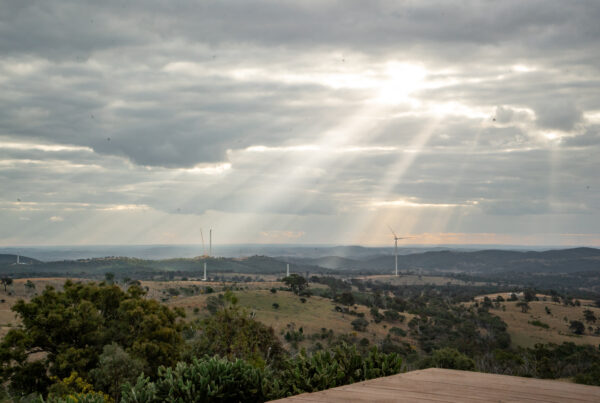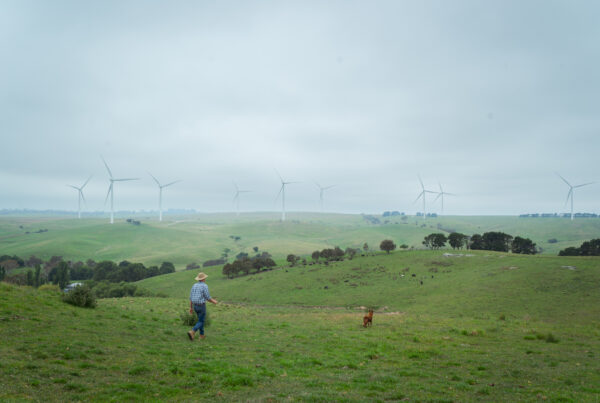Monday, 5 February 2024
Farmers came to Canberra today to send a message that renewable energy makes farmers money, as Farmers for Climate Action released polling showing big support for renewables in the regions.
Regional polling of 687 residents across Central Queensland, Hunter and Illawarra, conducted for Farmers for Climate Action over the past fortnight and released today, found:
- Regional people believe renewable energy projects (25.8%) to be the biggest opportunity for their local regions in the next 20 years, followed by tourism (23.7%) and healthcare employment (15.4%)
- Regional Australians said increased fires and floods driven by climate change (36%), bad conduct by supermarkets (25%) and increasing cost of insurance and fertiliser (13.2%) were the biggest threat to farming in their local regions. Just 3.9% nominated the construction of transmission lines on farmland.
This follows a huge Farmers for Climate Action survey of 518 farmers in December, distributed through the NFF social media channels, which found only 1% of farmers saw transmission as the greatest threat to their farm and only 0.6% saw renewables as a threat. More than 55% of farmers nominated climate change as the greatest threat to their farm, with 14.8% choosing bureaucracy and paperwork and 8.6% nominating water availability.
Farmers for Climate Action Chair Brett Hall said farmers making good money from renewables projects weren’t hard to find.
“Income during drought is vital when you’re trying to run a family farm and renewable energy delivers that. Typical payments being offered to farmers by wind companies are now more than $40,000 per turbine per year, and many farms host dozens of turbines whilst still farming sheep or cattle. Solar companies are now offering farmers around $1500 per hectare per year rent, and the farmer often continues to run sheep under the panels. Strong competition between renewable energy companies means farmers are choosing the best deal for them and their community. The current National Farmers Federation President makes money from wind turbines on his land, and so does another previous NFF President. Sun and wind are modern commodities which make farmers serious money. “Renewables help keep family farms profitable.”
Crookwell sheep farmer Charlie Prell said his farm hadn’t been making money during the drought – then a wind company came along.
“Our family farm wasn’t financially sustainable during the drought until we hosted wind turbines. Now the farm has substantial, bankable income locked in every year whether it rains or not. And now we’re selling, the real estate agent says the secure income from renewable energy is driving my sale price up by hundreds of thousands of dollars. Renewables saved my family
farm,” Mr Prell said.
Horsham grain farmer Susan Findlay Tickner has five wind turbines on her family farm as well as five and a half kilometers of transmission (14 transmission towers).
“The wind brings us stable income, locked in regardless of whether we have a huge harvest or a poor one,” Mrs Findlay-Tickner said.
“We’ve been farming under transmission for 50 years without issue. We run harvesters under them and farm around them just like we farm around trees. Some people claim you can’t fight fires near turbines but I have photos of aerial bombers extinguishing a fire between ours.”
Andrew Locke farms sheep and cattle at Walcha in New England and has signed up to the proposed Winterbourne Wind project along with about 50 other local landholders.
“This project will make our farm business more sustainable despite drought and volatile livestock prices. We’re also pleased the local community will benefit directly through a $40M Community Benefits Fund,” Mr Locke said.
Wellington grazier Simon Barton said renewable energy was now the farm’s main income.
“Renewable energy payments are the main source of income on our family farm now. The wind turbine income has been vital for us,” Mr Barton said.
Wellington fine wool farmer Tony Inder’s sheep graze under the panels at a solar farm.
“The sheep I graze under the solar farm produce better wool, I think because there’s more even nutrition given the panels create shade in summer and provide a wind break in winter. My sheep are part of a study investigating this. Farming helps renewables and renewables help farming.”
Tasmanian sheep grazier Roderic O’Connor farms 22,000 sheep and is installing more than half a million solar panels, which the sheep will graze under.
“Having the solar farm fenced in sections will enable more rotational grazing and, given the lower value grazing area it’s situated in, these solar panels will actually increase sheep numbers and production on our family farm,” Mr O’Connor said.
“My remit in life is to leave a legacy. To ensure my family and future children can remain farming. A very large on-farm solar project fits this future picture perfectly and will provide substantial income for our farm, even during drought.”
Toogoolawah beef farmer Caitlin McConnel uses panels which rotate to follow the sun.
“It’s really been that solar income that has been keeping our property profitable,” she said.
Media contact: Les White 0409805122, media@farmersforclimateaction.org.au






Terrific on-farm snippets in this article thanks, which gives me hope for dual purpose farms. Especially as it MIGHT keep ownership in the hands of families, and give next generation family members enough grip to take the risk to stay in the farm.
My question regards small farms – can they offer up a paddock or borderline, to help the atuon and simultaneously supplement our income too? Small farms are particularly vulnerable to going under as prices continue to rise well above our productivity capacity these days (insurance, labour, machinery amd more). However small non-corporate farms usually mean there’s a family living in the community, filling the schools, the supermarket, contributing to the full life of rural Australia. How do small farms put their hand up for turbines, or solar arrays?